Centerpin Fishing For Steelhead: 13 Tips From Expert Guides
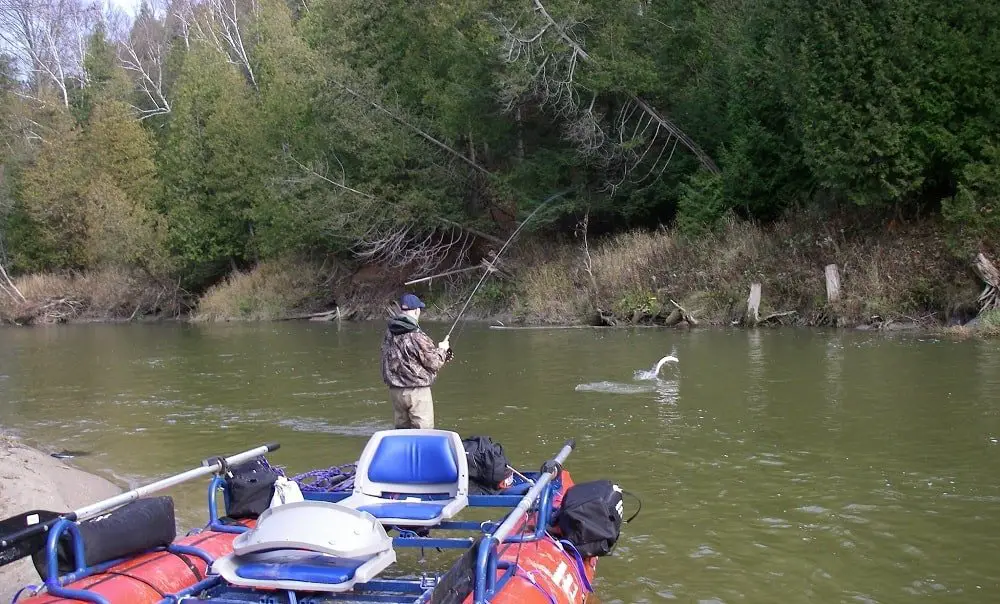
If you are new to Centerpin fishing, let me quickly explain what it is. Centerpin fishing for steelhead allows you to present a bait in a natural way under a bobber using a special reel called a Centerpin reel, which is combined with an extra-long rod, and together, they enable you to get a great presentation.
37 years ago, I was only 17, and I saved for six months so I could buy my first centrepin reel.
When I started, like most anglers, I struggled with my cast, I struggled to get steelhead on the line, and then I struggled to land the steelhead I hooked.
Today, I am the top Centerpin guide and instructor in my area, and I have taught over 1000 anglers how to centerpin fish for steelhead properly. I might also be the first guy ever to offer Centerpin fishing classes.
There are two main things you should know about Centerpin fishing.
The first is that most anglers think Centerpin fishing is simply just casting your float and bait out, watching it drift down the river, and then you wait for a bite. The guys that do this catch very few fish!
The second thing to know is that Centerpin fishing is the most effective method for float fishing for steelhead, but, only if you do it properly. This is why guys will email telling me they have fished all spring and haven’t caught a steelhead yet and they need my help, yet my buddies will text me telling me they just hooked over 60 steelhead in about six hours on the river.
Why do some guys catch hundreds of steelhead in and other guys catch very few in the same amount of time of the water?
Like all float fishing and steelhead fishing methods, Centerpin fishing is a skill and once you figure it out, you can catch ten times more steelhead than you could if you don’t figure it out.
There are four key fundamentals to Centerpin fishing and float fishing that you need to know and do if you want to be good at it. In this article, I’ll explain the fundamentals and provide the same tips and advice I give to my clients.
Key Takeaways
- Rod and Reel: I recommend a decent centerpin reel and a long centerpin rod of eleven to 14 feet long. The rod and reel combined enable very good presentations. You can not centerpin fish well with short rods.
- Centerpin Line: The line is critical to a good presentation, which is why I recommend specific lines that are lightweight, buoyant, and manageable. The right line will improve your presentation and catch.
- The Float / Bobber: The bobber used in river fishing is called a float, and good floats will actually do more than just detect a bite. Understanding all the things a good float can do will help you catch ten times more steelhead.
- The Setup: The leader MUST be set up properly, and if you want to catch the most fish possible, you MUST use a proven setup that works for the type of water you are fishing. I will show you this.
- Presentation and Covering Water: One of the things I teach is how to present your bait in a way that will trigger the most bites from a steelhead. I also teach how to cover the water from top to bottom, and side to side, to put your bait in front of more steelhead.
- Hooking and Playing Steelhead: If your presentation is good, you’re going to need to learn how to get a good hookset and play your fish so you don’t break it off or play it forever, as most new anglers do.
My experience has shown me that if you screw up any of the above things, you can drastically reduce your ability to catch steelhead with a centerpin. And even if you are already catching a few steelhead a day now, maybe you should be catching ten a day.
Float Fishing Vs. Centerpin Fishing
Using a float to present your bait to steelhead is called float fishing, but when you use a Centerpin reel to do it, it’s known as Centerpin fishing.
Float fishing can be done with a Centerpin reel, a spinning reel, or even a bait cast reel, it all the same thing.
A Centerpin reel works better for float fishing than spinning reels or bait cast reels because the Centerpin reel allows you to feed line out effortlessly and smoothly and enables you to control the speed of the line so that you can control the speed of your float and the speed of the bait and all that provides you with the best presentation possible.
Centerpin Fishing Species
You can Centerpin fish for trout, steelhead, salmon, and even smallmouth bass or carp in rivers.
Centerpin fishing can work for any fish that is in the flow of the river.
Centerpin Fishing Rivers
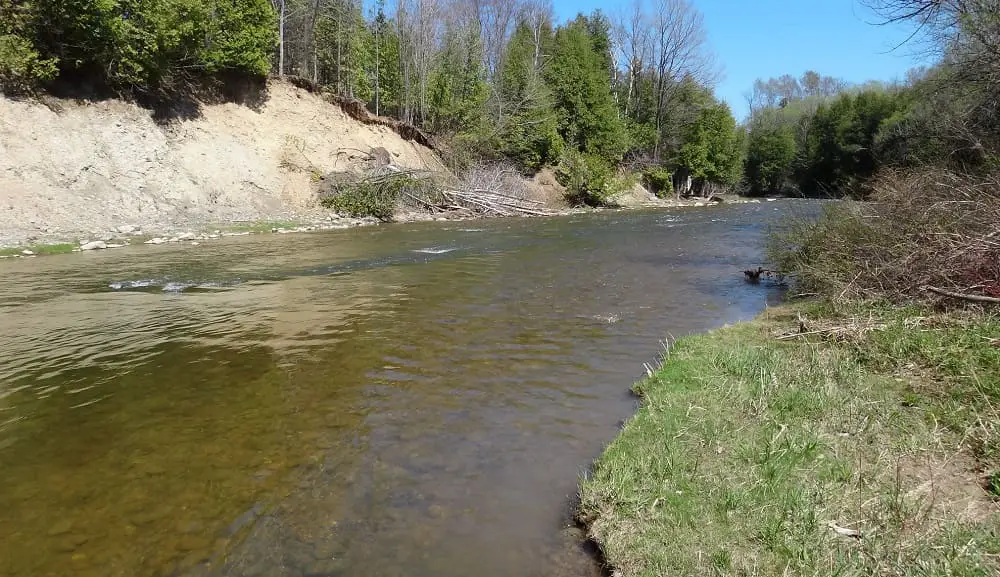
Centerpin fishing for steelhead is great in any river wider than 20 feet, but it is not limited to larger rivers.
Under the right conditions, you could even fish in small creeks that are 5 to 10 feet wide as long as there is some current to move the float.
Centerpin fishing is very effective in slow-moving water as well as very fast water. Due to the leader setup and the float, the best rivers for Centerpin fishing are 3 feet deep up to 12 feet deep.
It’s difficult to Centerpin fish in shallow water under 3 feet deep so if you encounter a river that is very shallow, it’s best to use the advanced bottom bouncing method I discuss on my Bottom Bouncing page.
The Centerpin Reel
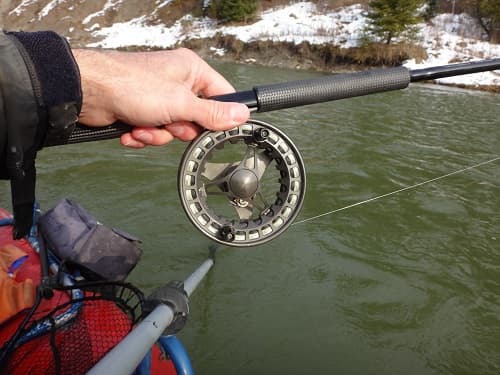
The Centerpin reel looks like a large fly reel, but a Centerpin reel has no drag system and is basically a spool that sits on a center post that free-spools both ways.
I discuss over 20 of the best Centerpin reels on my page 23 Best Float Fishing Reels Of 2021: Buyers Guide.
The Centerpin Rod
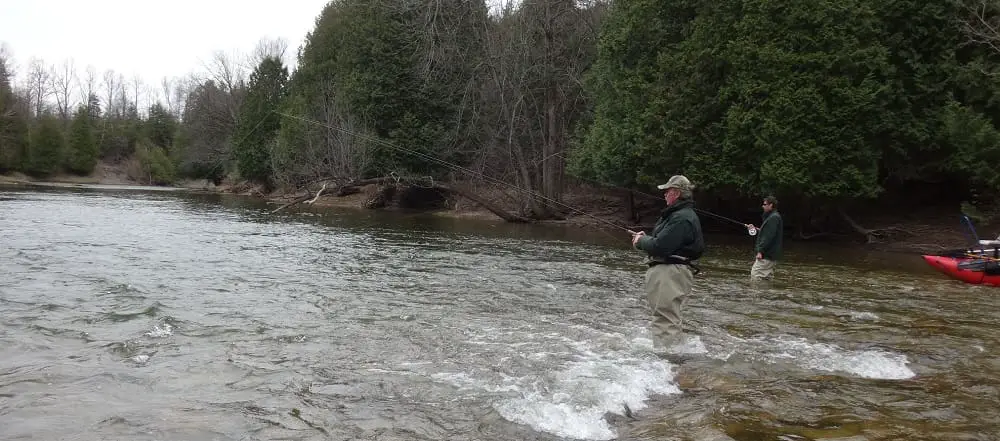
Long and light rods are the name of the game when it comes to Centerpin Fishing. An average size Centerpin rod is around 13 feet with a line rating of 4 to 10 lbs for Great Lakes steelhead fishing, or around 8 to 16-pound line rating for very large fast rivers and West Coast steelhead.
The reason we use such long rods when Centerpin fishing is that the longer rod allows us to keep the line up off the water on long drifts, which allows us to have better line control and float control and an overall better presentation.
The long Centerpin rods also act like a giant shock absorber so that we can use lighter leaders on big steelhead that might be line-shy. The long rods also protect the leader on hook sets. Not to mention, these long Centerpin rods are fun to fish with.
But not all Centerpin rods are equal, with some being better much better than others. I have an entire page on Centerpin rods called 7 Best Centerpin Rods.
The Centerpin Line
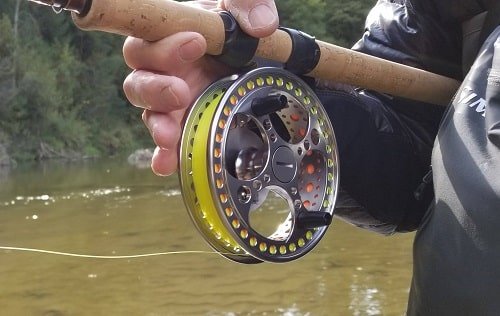
Monofilament lines and braided lines work well on Centerpin reels.
One thing you need to ensure is that the line is supple, is not too heavy, and is buoyant.
The best Centerpin line for Great Lakes steelhead is the 8-pound Raven Mainline in yellow, and I recommend it to all my clients. If you fish in bigger rivers or the river has a lot of steelhead over ten-pounds I would suggest the ten-pound Raven Mainline.
For steelhead fishing on the West Coast, I would go up to a 12-pound test.
I also like to use and I recommend using bright colored lines (like the line in the above picture) because these brightly colored lines can have a lot of advantages as long as you set up your leader properly.
Check out my page, Best Centerpin Lines: What The Guides Use. I discuss all the lines that I have used, tested, and recommend.
Terminal Tackle For Float Fishing
When it comes to Centerpin fishing and float fishing with spinning reels, we use all the same terminal tackle, which includes floats, leaders, swivels, weights, hooks, and baits.
The Best Centerpin Floats
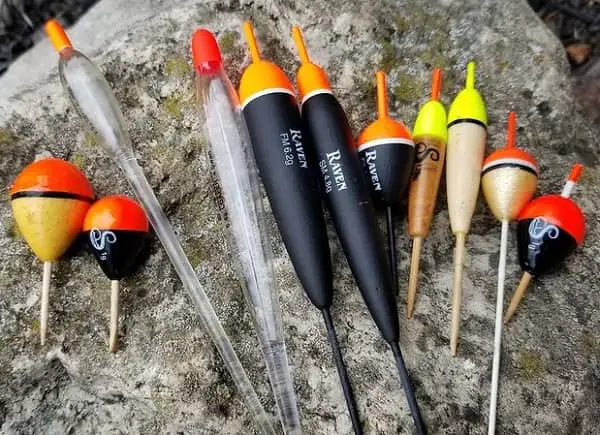
Some anglers will call them a bobber, but the correct term when river fishing is a float. Floats are a key component of Centerpin fishing, but not all floats are good for float fishing in rivers.
A good float does more than just tell you when you have a bite, and a good float is critical to a good presentation.
For float fishing in rivers and creeks, you want a longer, narrow float designed specifically for river fishing. My favorite, and the one I use for guiding, is the Raven Premium Balsa Floats – Model FM in size 4, 6.2-gram, and 8-gram.
I have an entire page on the Best Floats For Centerpin Fishing – HERE.
Leader For Float Fishing
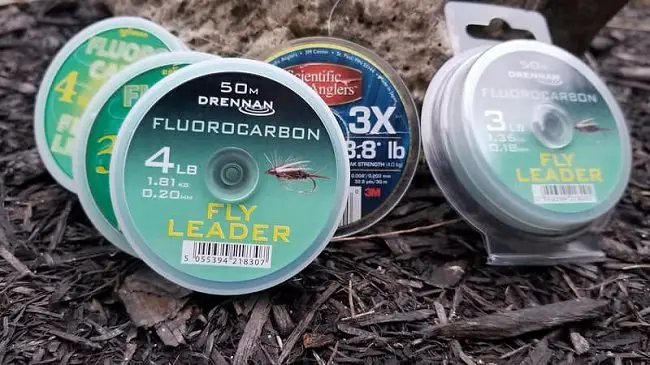
The leader attaches to the mainline which is where you attach your weights, hooks, and your baits.
I highly suggest that you use the right type of leader, the right size of leader, and that you set it up properly.
You should always use Fluorocarbon leader material and ensure the right diameter.
Guide Tip: When buying leader material, go by the diameter size and not the pound-test listed on the label.
- Use 0.20mm diameter (8lb) for most Great Lakes steelhead.
- Use 0.22mm to 0.24mm for larger and faster rivers, and for West Coast steelhead.
Steelhead Leader Setup
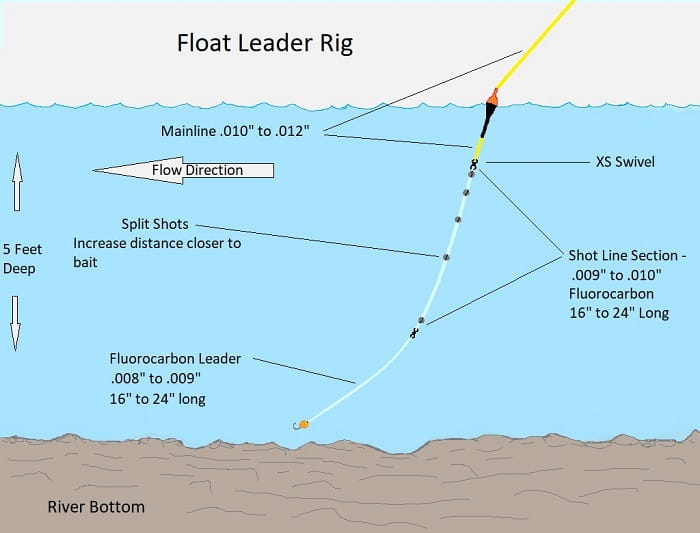
The Steelhead leader setup is a critical part of Centerpin fishing. The right leader setup will help you get the proper leader angles and a better presentation of your bait.
I use two swivels, two different line diameters, spit shots, and a great hook for my leader setup.
There is a lot that goes into my leader setup, but since my clients and I hook over 500 steelhead most years on this leader setup, I garantee that it is proven to be the most effective leader setups available.
If you want to see how to set up the leader, go to my Best Leaders For Float Fishing page.
Swivels And Weights For Float Fishing
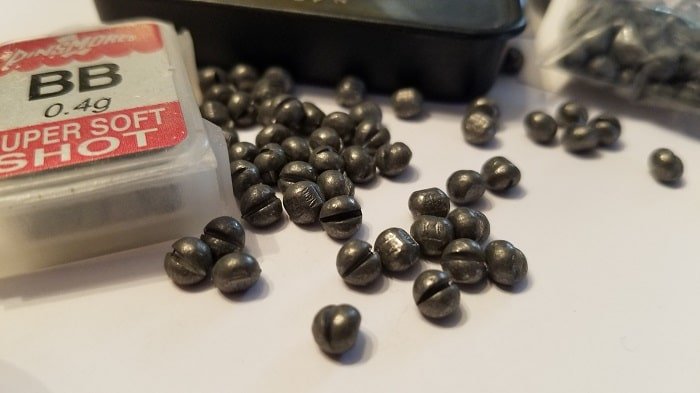
I use micro swivels to attach the leader to the mainline and the lower leader to the shot line (see diagram above).
The shot line is a separate portion of the leader where all the weights go. If you set this up properly you will improve your success.
Use round split shots that are black or dull grey in sizes BB to AAA for most trout and steelhead situations. Do not use shiny split shots with the removable wings.
Best Hooks For Float Fishing
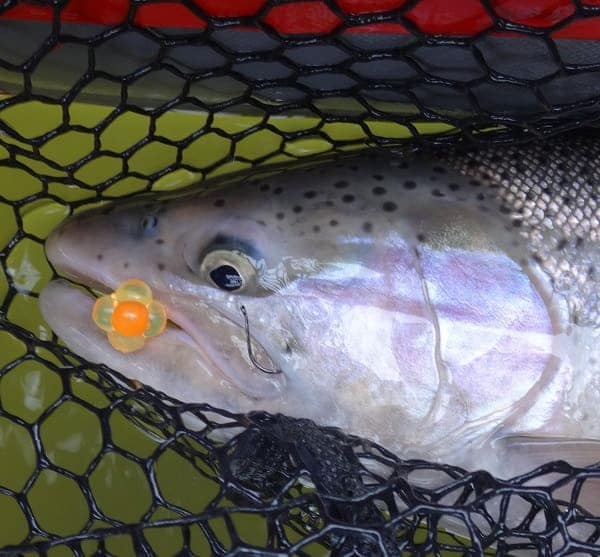
Expert guides are very picky with the hooks they use. Some hooks hook better and hold better, so use the right hooks.
A hook that is too big may be seen by the fish and ignored, or it could cause problems with your presentation and even snag up more.
A hook that is too small can break, bend, or come out too easily, and you could lose a fish of a lifetime.
I mostly use Raven Specimen hooks, Gamakatsu Octopus, and Raven Sedge hooks in sizes 6 to 10, (size 10 is my go-to size in clear water). However, there are a few other good hook options for float fishing.
The Best Baits For Float Fishing
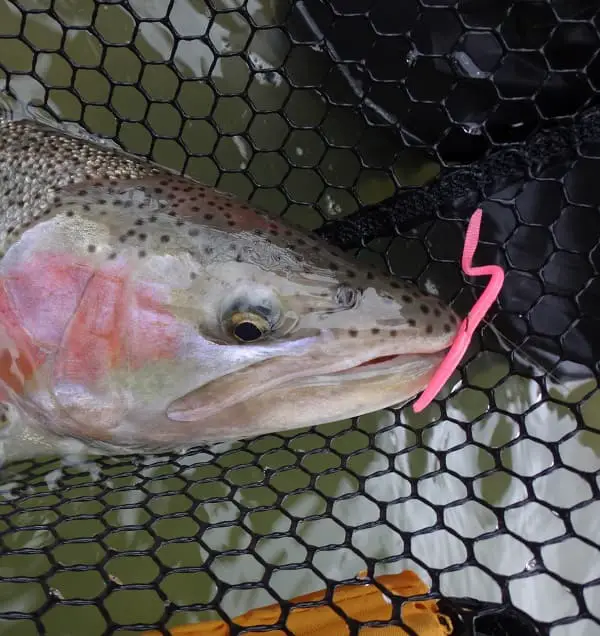
Using the right bait at the right time will greatly increase the amount of fish you catch, but you still need to present it well. otherwise, even a good bait can become useless.
I would think this makes sense, but I still see guys putting all kinds of dumb stuff on their hooks all the time. Ninety percent of the time, I use these baits.
- Spawn bags – Use multiple colors and sizes based on water clarity and conditions
- Worms – Pink and Red plastic worms are hot baits.
- Beads – Glass, hard plastic, and soft beads are very good baits
- Flies – The same artificial flies that fly anglers use, like Woolly Buggers, stoneflies, and Egg Sucking Leech are good to use under a float.
In most river situations, you can’t go wrong with live or plastic worms, spawn bags, and flies, but I use some other very effective baits when Centerpin fishing.
The 4 Fundamentals of Centerpin Fishing
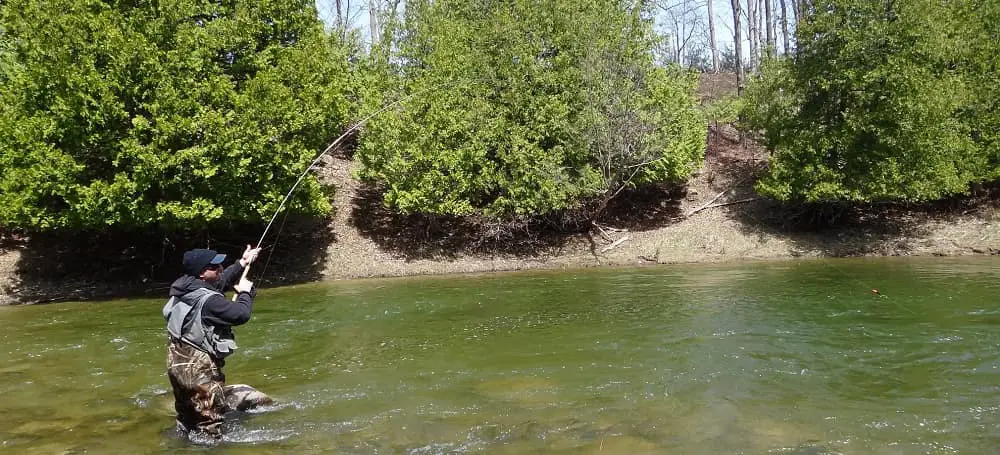
Catching steelhead with a Centerpin takes some skill and knowledge along with some practice, and just because you have all the right gear and tackle doesn’t mean you are going to start catching fish like everyone else.
These are my four fundamentals of effective Centerpin fishing that you need to learn if you want to become one of those guys who catch all the fish.
Set Up For More Success When Centerpin Fishing
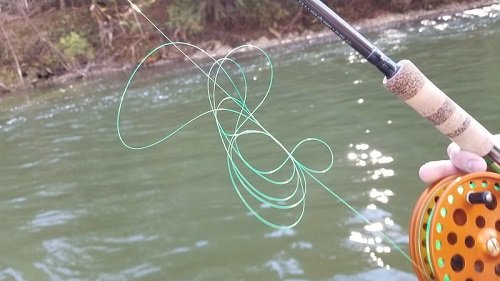
One of the fundamentals is how you set up your rod, reel line, leader, and even how you put on your bait.
Setting up your leader wrong can mean no fish at the end of the day, even if you are good at the other three fundamentals.
Using an old line or a line that is too heavy will prevent you from catching fish.
Using the wrong float, the wrong weights, or the wrong hooks can also prevent you from catching fish.
Make sure you have all the stuff you need. Check out my page, Centerpin Fishing Gear: A Guide Recommended List.
Cover The Water Effectively When Centerpin Fishing
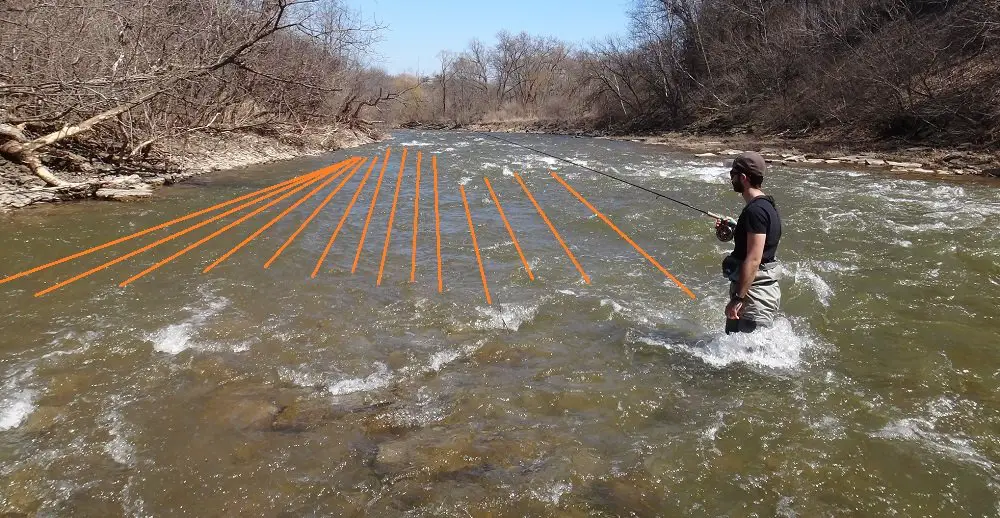
You can’t just stand anywhere when Centerpin fishing. You need to be standing in the right spot, and that spot is above your target area. As float fishing anglers, we fish from the top down so we can cover the water effectively and control the speed of the float. This is critical to good float fishing.
Positioning yourself at the top of the pool to fish and making long drifts from the top of the pool to the bottom of the pool is important if you want to catch the most fish. Once your drift is complete, you want to systematically move each drift a little further, about a foot at a time, until the entire pool is completely covered.
You can see how this is done with the orange lines in the above picture.
Normally I would have had the angler in the above picture fish from the bank but it had too many hanging trees. I would have had him stand back about 15 feet so his rod tip was about where the first line in the middle of the river is, but the water was too fast for him to stand.
Sometimes, you need to make exceptions, but try your best to be in the right spot.
I discuss this in more detail on my page, Effectively Covering The Water When Float Fishing.
Find The Bottom When Float Fishing
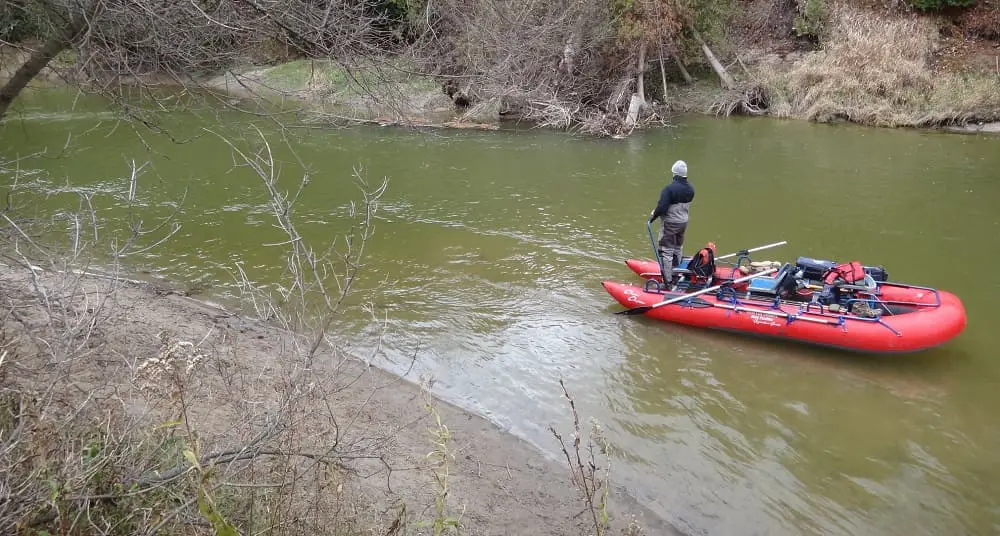
The steelhead are usually very close to the bottom, and much of the time, it’s very difficult to tell how deep they are. This means you need to get your bait down to the fish if you want to catch them.
Many guys make the mistake of either dragging their baits along the bottom or drifting their bait too far over the heads of the fish, and they rarely make adjustments to their floats.
I tell all my students that the first thing they should do in every spot that they fish is to find the bottom.
Having the perfect leader setup, and the best bait and then making a great drift is useless if your bait is 5 feet over the steelhead. Find the bottom, and you will find the fish.
How do you find the bottom? First thing I do is, I guess the depth just by looking at the spot I want to fish, then I adjust my float to what I think the depth might be, I usually start shallower than deeper and make a drift.
If I think the spot is 5 feet deep, I make sure the length of leader below my float is between five and six feet deep.
The first drift is to see if the bait catches the bottom or if the float keeps tilting downriver fast, which indicates the bait is dragging bottom. If it drifts freely without any tilting or bumping rocks, I make it a foot deeper and try again, then I keep repeating until I start hitting the bottom.
For more information on methods I use to determine the bottom and set my leader length, check out my page, How To Know How Deep To Set Your Float – 2 Easy Ways
Centerpin Fishing: Speed Control
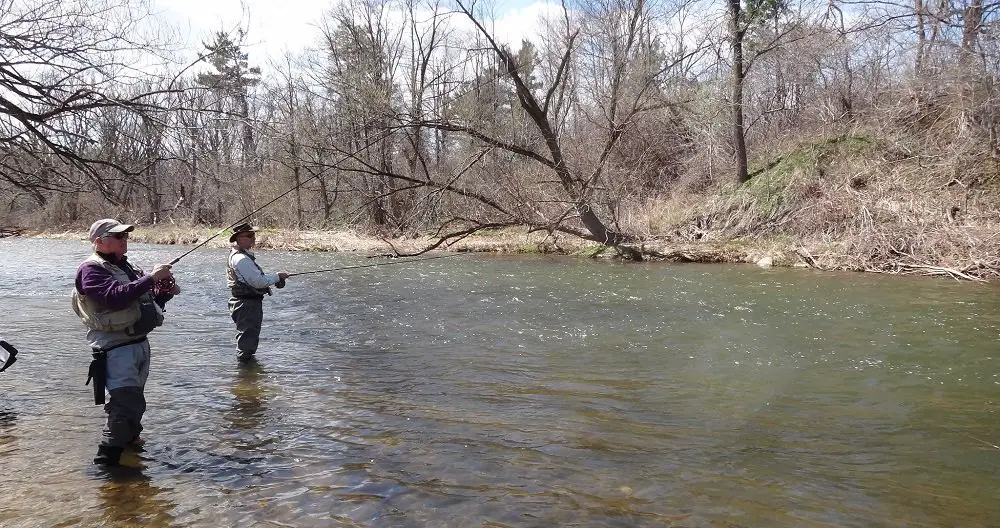
Speed control is the most important fundamental of all four when it comes to float fishing. I didn’t realize this until I started guiding, which is when I had the opportunity to watch hundreds of anglers fish and not catch any fish.
When I started guiding, I wondered why one angler would catch all the fish even though they both used the same setup and the same bait. Was it just luck? Eventually, I figured it out and realized that one angler was slowing their presentation down and the other guy wasn’t.
Slowing your bait down to match the bottom speed is critical, and slowing your float down is called trotting or checking your float.
Trotting Your Float For Better Presentation
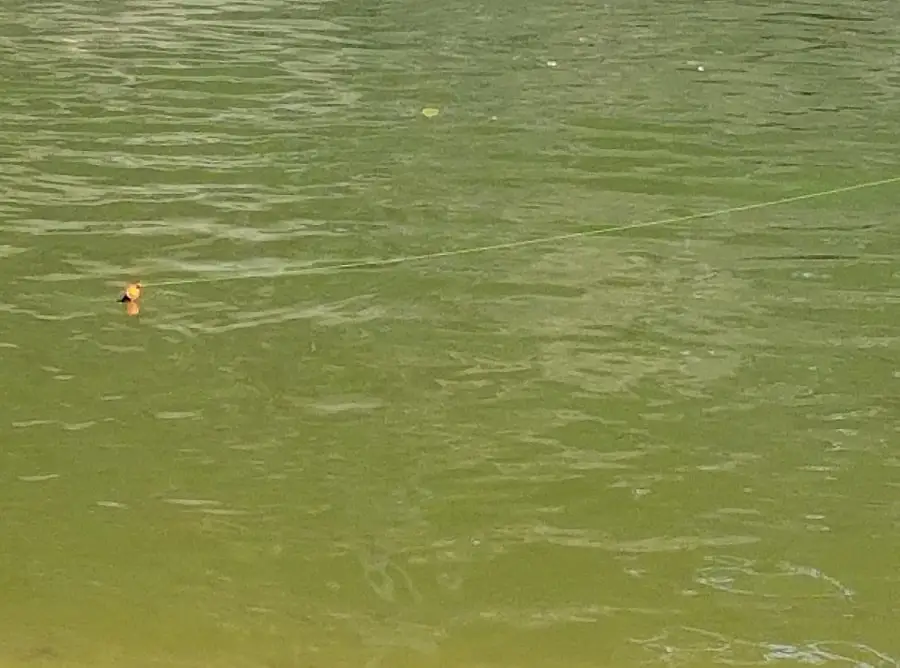
There is a thing in float fishing called trotting or checking your float and it is a very important concept to learn.
You can do this much better with a Centerpin reel than any other reel, which is why I believe that the Centerpin reel is superior to any other reel used in float fishing.
When Centerpin fishing trotting or checking your float, simply hold your float back so it moves slower than the surface current.
The real reason why trotting works so well is that if you hold your float back just enough, you can match the bottom speed better, which is where the steelhead are feeding.
Matching the bottom speed means that your bait moves in the lower water column at a speed that matches everything else that is drifting through that area. This way the bait looks more natural to the fish. It also gives the fish more time to see the bait and react to it.
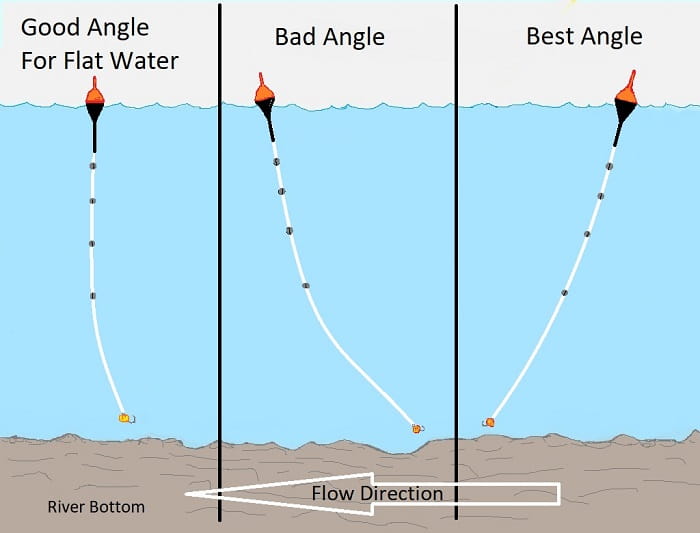
To do this well, you want to hold your float back just a little to get the right angle. You can do this by applying pressure or tapping the spool of the Centerpin reel.
Once you get that proper angle, you work your reel and control the speed of the line coming off the reel to maintain that angle throughout the entire drift.
To learn more about this very critical part of float fishing, check out my page, Float Fishing: Controlling Your Speed For More Fish
Understanding Steelhead Holding Water and Behavior
There are a few other bonus tips I will provide now that are really important if you want to be successful fishing steelhead with a Centerpin.
Knowing how to read the water is also important when fishing for steelhead. Knowing about travel routes and steelhead holding water will also greatly increase the amount of steelhead you will catch.
These holding spots will change throughout the seasons.
In the spring and fall, steelhead will hold or be in a different part of the river depending on water temps and what stage of the run they are in.
In the spring, I discuss the three stages of the steelhead run and how to capitalize on each stage. You can see my tips and advice for spring steelhead on my page, Spring Steelhead Fishing: Tips And Tactics From The Guides.
In the fall, I find that the steelhead will be in certain areas in October, but will be in other spots in November, and then in other areas in early December.
I also find that the times they feed and the types of effective baits will change. You can see more on that on my page, Fall Steelhead Fishing: Proven Guide Tips And Tactics.
Winter fishing is another story. Anglers can really struggle at this time of year, but anglers who know how the guides keep catching steelhead all winter will do very well. I discuss the changes that guides make when fishing for steelhead in the winter on my page, Winter Steelhead Fishing: Tips And Tactics Of Expert Guides.
Another thing that you should know is how to time the steelhead runs. Anglers who do this well will be catching 30+ steelhead a day.
On many rivers, the steelhead will move in and be concentrated and easy to catch. After a few days or weeks, they will spread out and be harder to catch.
If you know when a river starts to clear after it rises very high and gets muddy, you will be able to be on the river during the prime time. If you are too early, you will be fishing mud. If you are too late, the fish might be gone.
I record the flow heights and use the online flow charts to help me predict the best times to fish. I know that one river might clear 16 hours after it rises 2 feet, but another river might take five days to clear after the same rise in water.
Knowing this will allow me to be on the right river on the right day. I can fish a quick-clearing river one day and catch a ton of fish, and two days later be on another river that has just cleared and hammer them.
I record these levels on all the rivers I fish, and I know exactly how long it takes for each river to clear so that I can get my clients on the best river. I recommend keeping good notes and using the water levels websites for each river.
I also record what color and clarity the river is based on the levels shown on the charts.
If you have a question or comment or some advice you want to share about fishing steelhead with a Centerpin, let us know in the comment section below.
Tight Lines,
Graham

Graham. I thank you so much for easy language and thorough descriptions and pictures. Read this several times. Just 68 and fished since I was able. Nevertheless heard of center pin. But I do try to drift present so now ill do it right thank you I can buy fishing gear and tie some balanced leeches. Yippee. Grandma barb
Hi Barb,
Happy to hear, enjoy the website and all the new information coming soon.
Thanks Graham
Hi Graham. Thank you very much for this website, it really helped me out. As i am starting float fishing this year, and planning to drive from Quebec to Porthope next week for steelhead opening, i really learned a lot with all of your advise. I purchased a IM8 rod as you recommended, and got myself a okuma raw2 since it is conveniant for both new and experimented centerpin anglers. Also i am planning to use a Raven mainline 8lb test with a 5lb Drennan flurocarbon leader. The only unanswered question that i might have is, would you recommend putting backing line on my okuma raw 2 reel, and if yes, would you recommend a specific brand. Again thank you very very much for all your tips, you really made my life easier.
Hi Azam,
Great to hear that you like the website. A few things to consider.
1st. be prepared for lots of anglers and crowds at port hope as the opening weekend there is extremely busy. I recommend having a backup plan like Wilmot, Graham Creek, Bowmanville Creek, or Duffins creek. The good thing with opening weekend is you can watch other good centerpin anglers fish and cast and see how they do it.
2nd. Unless it is high and muddy don’t use 5 pouund drennan, I would recommend 4 pound drennan instead, or even 3-pound Drennan leader if the river is very low and clear and the fish are pressured. Better to hook some and lose them, than to hook none at all.. 5lb is too heavy for clear rivers and those rivers are very clear.
3rd, Before you set up your reel, make sure you know which hand you are going to reel with or you will make it harder for yourself to learn.. I try to always recommend that if you are right handed you should reel with your left hand and hold the rod with your right hand and vice versa. I explain why in the link below.
I always use backing whether it’s a heavy 12 to 20 pound mono line or fly line backing. I mostly use fly line backing on my reels. You can see my article on how to set up a centerpin reel at https://troutandsteelhead.net/how-to-set-up-a-centerpin-reel/
Best of luck,
Graham